This gathering was a chance to explore what is possible with the fabric of Maindee Library. We had the first opportunity to meet architects Sarah and George [who will be working with us until March 2018] and get some perspectives how the library space could be re-designed.
May New Paths - Focus on the Library
This gathering was a chance to explore what is possible with the fabric of Maindee Library. We had the first opportunity to meet architects Sarah and George [who will be working with us until March 2018] and get some perspectives how the library space could be re-designed. The meeting was also a good chance to start exploring opportunities and also remind ourselves about what exists already that is really valuable. Specifically Sarah Goodey discussed her experience of using Maindee library as a centre for creative workshops and John Hallam also provoked us to consider the space terms of being a place for social prescribing. Standing alongside these two presentations Rob Smith was able to outline his process for recording stories and how this would contribute to the library project and an eventual artwork.
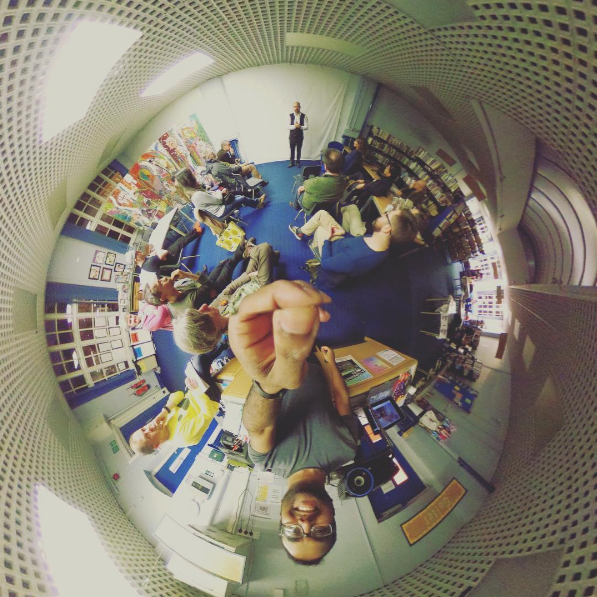
This blog post is a resume of the discussions with some pointers for us all to consider as we plan the architectual and artistic work which will last until March 2018.
#1. George Lovesmith and Sarah Hollingworth
Fez introduced the architects George Lovesmith and Sarah Hollingworth to the group. They were selected following a competitive interview process - supported and managed by Sarah Pace from Addo - for which nearly 30 practices applied for the role. George and Sarah, based in Bristol but with experience all over the UK and elsewhere, started by explaining how they work together as a team. They have worked on library buildings previously and are currently doing a park project in Plymouth. It soon became clear that they are interested in an approach where ideas are trialled and prototyped before being finally implemented. This relates well to our project as it gives the chance for library volunteers - and users of the building - to test whether different ideas can work first before setting them down.
George and Sarah described previous examples of projects where people had been able to take on practical tasks as they explored what could happen with the building. Sarah explains that this practical experimentation ‘builds energy and desire’; and she added that they are interested in how we all learn together from these experience. Sarah described one project in Plymouth where volunteers had been able to get time credits for the work that they did. John Hallam pointed out Maindee library volunteers had also earned time credits, but that that the Newport time credit system was slightly in limbo.
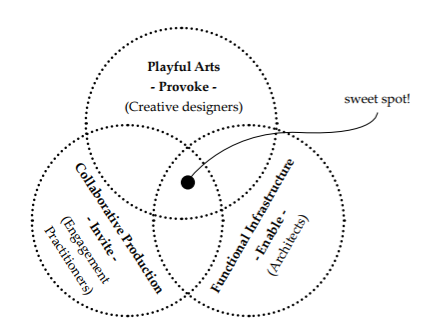
Our new architects are also very interested in local stories and narratives and how these can influence the changes to the fabric of the building. We asked them to speak at this event because we hope that our existing group of artists will connect with the work to the library, whether it is documentary photography, creative writing, opera or much more. We heard from George and Sarah that they are keen on working with people in a sense of co-production rather than consultation. Sarah noted from our blog and social media profile that we are doing lots of work with many different people. As such, they are looking to set themselves up curators who manage people’s ideas into becoming part of the library building.
Responses to the presentation
Dave Moses, chair of Maindee Unlimited (MU), spoke up first and said that we need to first solve the basic issues related to heating and lighting in the building - especially as this would soon be the responsibility of the charity rather than the Council [we will have a full lease in the next few months]. Both George and Sarah responded that it made sense to get these pragmatic items sorted first before moving on things which are more creative.
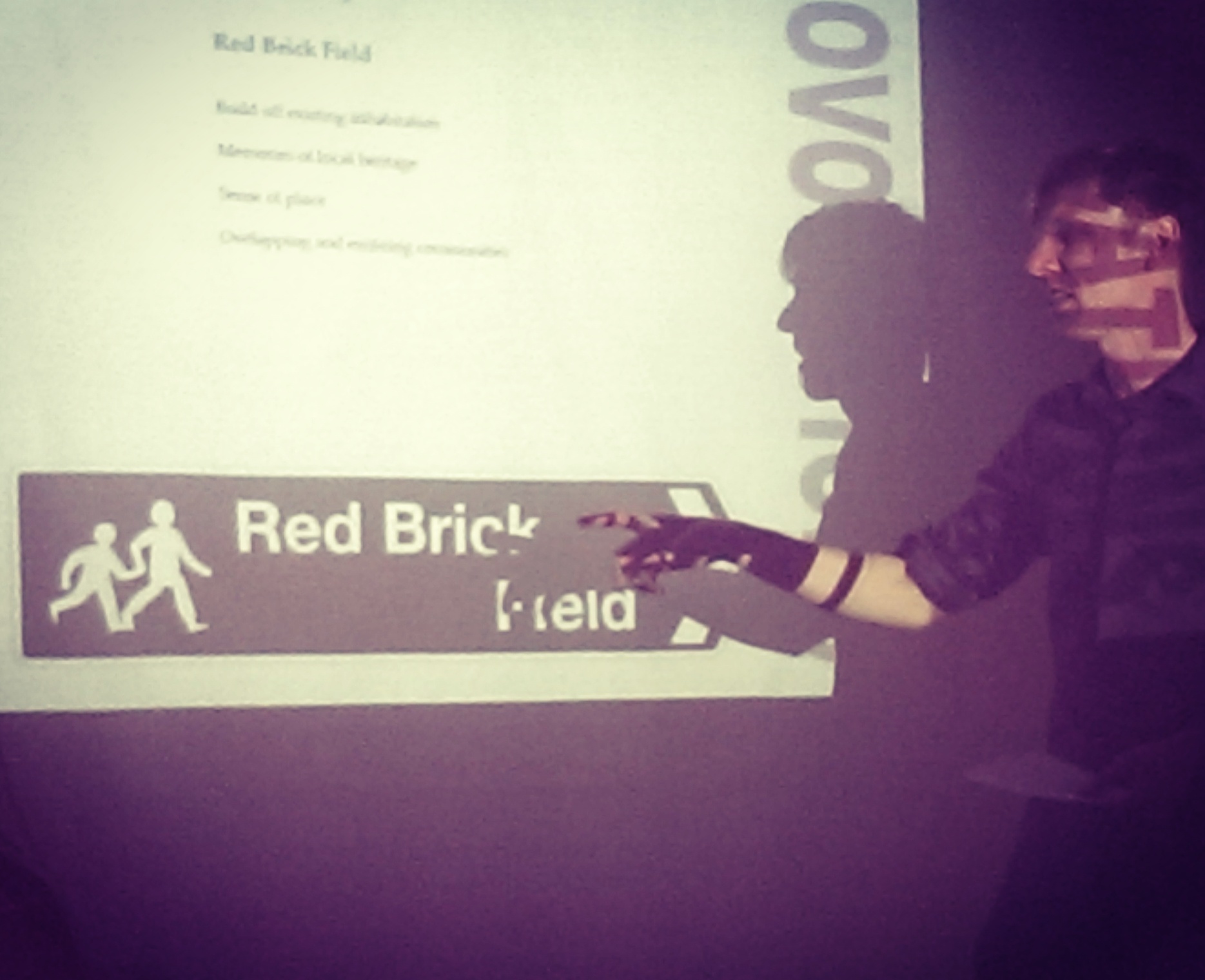
A question came in from Peter Anderson, representing Vocal Eyes in Swansea. He explained that Newport City Council had recently commissioned a report about how Newport could be a City of Democracy. As such, he described how early democracy projects in Stow Hill and Pill did not seem to have taken off, so maybe Maindee as a base for testing the concept? John Hallam acknowledged that Maindee Library was an exercise in working out how to make decisions… so testing concepts of democracy. As we concluded the question and answer session with Sarah and George Dave Moses again reiterated that the library volunteers were the main constituency whose voice should be heard as the future building is shaped.
#2. Rob Smith - Sounds of Maindee
We moved on to Rob Smith’s presentation about his Sounds of Maindee New Paths project. Rob presented a mindmap [below] and explained how he is going to capture stories and incidental sounds of Chepstow Road. He argued that times change and that it is important to record them not just visually, but also sonically. He plans to create a digitally-referenced system that is open for all to sample, with links to the People’s Collection Wales.
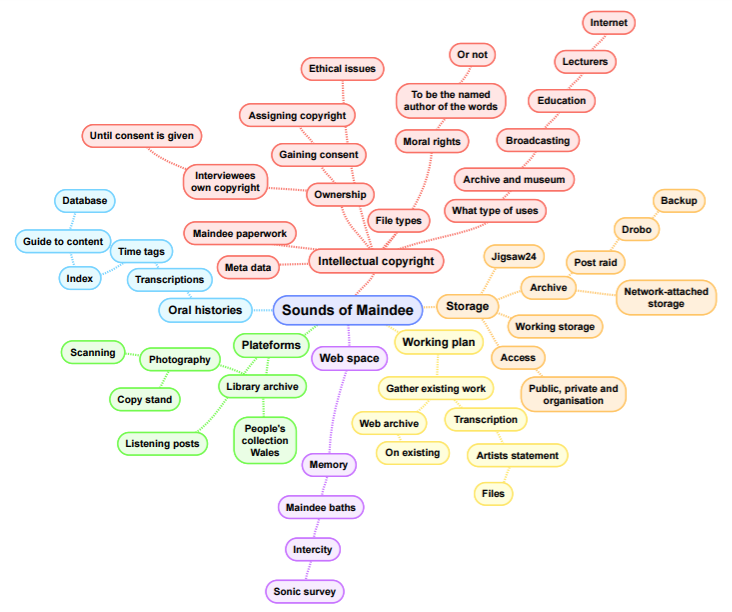
Rob’s immediate priority will be to record ideas and stories that help to shape the fabric of the library - explicitly tying in with Sarah and George’s work. Rob will be working with our trustee Jo Sutton who is writing an article for the Engage Journal about the library project and how it is being shaped. As such, Rob’s audio-recorded stories with their meta-tagged content could form some kind of archive for the library itself.
As we opened to questions, Marion Webber [who has spoken here before] explained that she was generally dropping the word interview in the work that she does on the digital heritage project at Community House Eton Road. She suggested that it is more a question of gathering stories; and letting people direct how they do this. Rob agreed strongly with what Marion said and explained that he had found something similar as he developed an exhibition called ‘Human Fabric’ about the former British Nylon Spinners factory. Rob’s work is currently on show through the Diffusion Festival at the Sustainable Studio on Curran Road in Cardiff.
Peter added further commentary about creating archives. This led to a discussion where John Hallam explained that the Finding Maindee project was about creating new stories and memories about living in Maindee today; not about getting lost in the past. We hope that people will work with Rob over the coming months.
#3. Sarah Goodey - creative use of space
Sarah works for Gwent Arts in Health - a charity based around the local health board. Sarah has lots of experience organising arts sessions across many different venues. Since the start of this month [May 2017] she has organised weekly creative writing sessions at Maindee Library - Wednesdays between 1pm and 3pm. This particular project is called 'Healing Words' and is part of celebrating creativity in older age Gwanywn Festival and has involved working with Mike Church as the facilitator. At the last session [the previous day - see photo below] the group had been given some homework to do ahead of the next session; in this case writing something positive and comical about Newport.
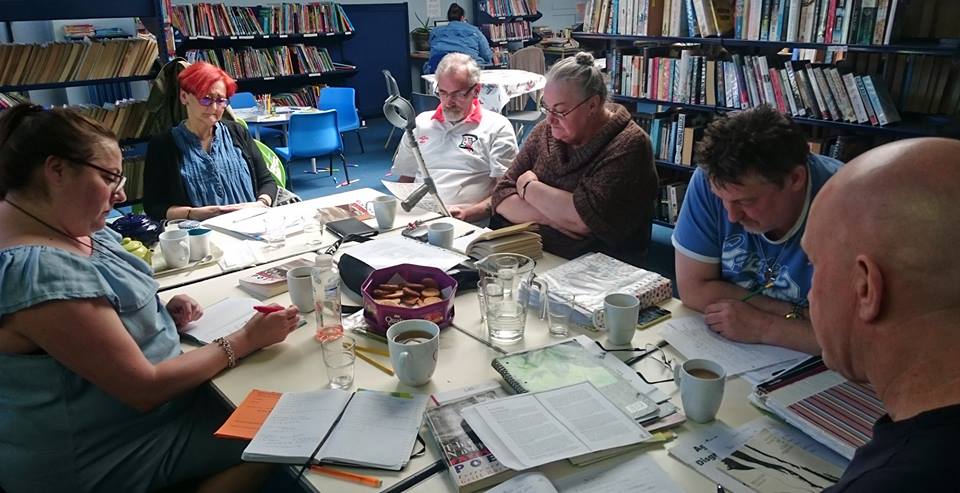
Sarah described how people had come together for this purpose rather than being a regular existing group; and that the people were not necessarily the same from week to week. Sarah explained that the participants had found that the library was a good place to hold the sessions. For example having lots of space around the table where they held the session meant that people could take a break easily, drop in and out and not feel claustrophobic as they may have done in a smaller room. These free sessions will continue through May and it is hoped that something could follow on afterwards - should the group be interested.
Dave Moses explained that another group, focused specifically on friendship, had used a space at the other end of the building on the Wednesday morning before ‘Healing Words’. This led to a discussion about what sort of space we would like in the library; whether to have a dirty sink for things like painting or even the desire from Alison Starling to have a kiln for firing ceramics. Sarah explained that you can make allowances in the space as it currently exists, for example covering the floor with a tarpaulin and so on. She also mentioned that the length of the room was a bonus. These are all factors to consider as we get into the architectural detail.
#4. John Hallam - health, illness and social prescribing
John linked his discussions quite nicely with what Sarah had been talking about. From his background of a working career in the NHS John helped us to sense that words like ill, well, happy, sad and so on have complicated meanings and are often problematic. The term wellbeing was pinpointed as something which is emerging now that NHS and social care as services are getting more challenging to fund and provide. For example, it is harder to recruit GPs in places such as the valleys of south Wales and also Newport East - where Maindee is located.
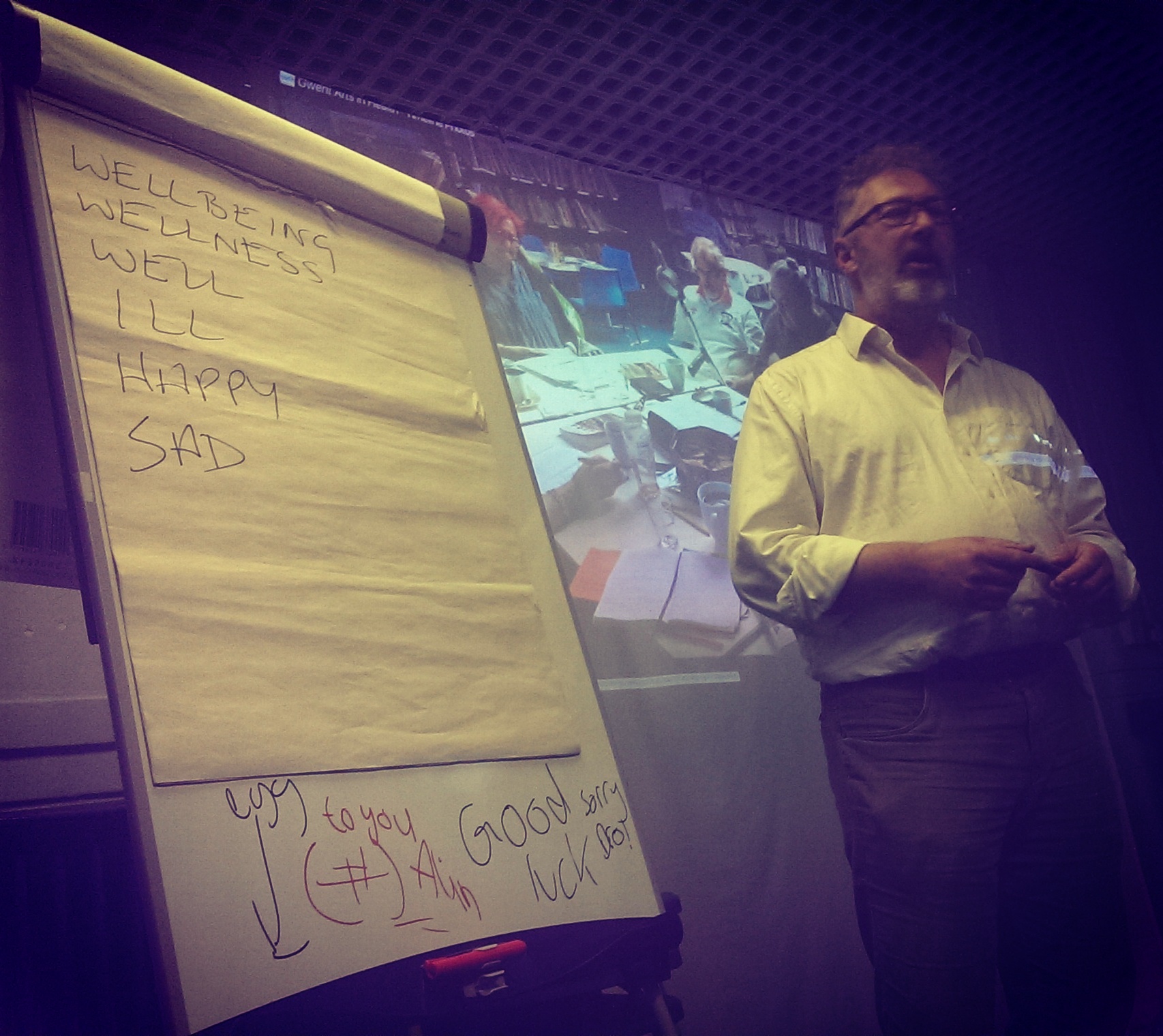
John explained that new models of social prescribing had emerged recently, particularly from a place called Bromley by Bow in London. The concept is that people do social activities which help with their mental and physical conditions; a place such as Maindee library could be a venue. In terms of this library building John explained that we should avoid being a community hub and maybe see ourselves more as the unum vas, vas bene clausum (‘well-sealed vessel’) - as described by Karl Jung. John drew an image of the vas or vessel as something which contains many different elements and which has some sort of heat or energy below it which sustains the alchemy. It is fortunate that we are taking an artistic approach to our work and so we can explore challenging [but potentially excellent] concepts such as the unum vas...
The challenges of meeting wider agendas - such as wellbeing
John described how public health bodies are 'knocking on the door' to use facilities such as Maindee Library. Rhian Hutchings agreed with this sentiment and explained that she is starting to have more of these conversations with health organisations through her work at ArtsWorks Cymru. If we follow this route John then asked whether this could this result in the library having a waiting list in the sense of a GP surgery? Focusing harder on this point, Sarah Goodey started to explore the boundaries between creative workshops and activities designed for people with mental health issues. She talked about the pathways that people follow [in a medical and health sense] and cautioned that there are specific things that only mental health practitioners should take on. Would volunteers need to have specific training in mental health? Should there be discrete spaces within the building for such activities? We will need to ask ourselves some hard questions over the coming months.
The conversation which resulted from John’s presentation, and complemented by Sarah’s extensive professional experience, deserves a meeting in its own right. If we are make some conclusions, however, they would centre our attention on the opportunity that this architectural and artistic project has to shape the library and its future usage. At present the business model is based on being completely volunteer-led, therefore having minimal overheads, and where spaces in the building are hired out for different sessions. John Hallam explained that we had taken £12,000 in rental revenue over the past year. None of this income is guaranteed it must to reiterated. Furthermore, to be responsive to a wide variety of room hires it is clear that different cultures must exist alongside each other in this space.
How cultures embed themselves within spaces
If we understand cultures as behaviours and practices, this building has a number of inherited identities from when it was a Council-run facility; such as people who come in and ask for the types of services which other libraries in Newport offer. As we develop more of an identity library volunteer Trish Johns emphasised that:
'This is a library in Maindee and not just a library.'
As such local culture and heritage has an opportunity to be developed. Our new architect George Lovesmith asked about the term 'Llyfrgell Maindee Library +' with the sign ‘+’ at the end. This appears on the Facebook page and in other places… in response Fez and John walked to the other end of the room and found the two large signs, hand-painted by Dave Wakely, which have not yet been put up. Clearly there is now a chance now to consider plans which have never been properly realised and to look at signage in much more detail...
On the point of the ‘+’ a wider argument was developed by Ismeal Velasco, an artist who has recently become a resident of the area. He has seen from his recent work that many of the people who spend their time in Maindee, and contribute to the events such as this evening, don’t actually live here; he therefore proposed that we consider Maindee as what he calls a ‘scaleable community.’ As such, he asked whether this library project was a chance to reach out further than just Chepstow Road or even Newport. Ismael provided the example of Cardiff’s Chapter Arts Centre, located off a road in Canton [Cowbridge Road East] that has many similarities in look and feel to Chepstow Road.
Returning to the point of the ‘+’, he suggested that there was bigger plan for this library than just it being a library. John Hallam responded by saying that ‘this is the space’... the library had inherited some of the creative energy which was built up by the Project Space on Commercial Street and also that receiving the grant of approximately £1/3m from the Arts Council of Wales (ACW) was fuelling some things. He also explained that receiving the ACW money was a big surprise to many, none more-so than himself. John helped to close this session and articulate that from this building we can start to support a movement and help to build community spirit, with a knock-on effect for housing, local economy and much more.
And trying to finish the session
It was very hard to finish this lively session on time… George Lovesmith started to explore how people may get in touch with him in the coming weeks and months. Speaking from the audience, Eugene Dubens [a presenter from last month] suggested the VocalEyes system as an online platform for having open dialogues which then get moderated by given editors. Peter Anderson described the latter system as being like the online data collection system SurveyMonkey, but on steroids! A discussion emerged from the group about the use of such tools and we are sure to explore much of this in the near future. As we finally concluded it was reaffirmed to the group that we now have an architectural practice in place and a budget assigned to the development. We also hope that being open about our practice - such as publishing these blogs - will help to generate trust and interest.
Of great importance is that artists will play a significant role in the shaping of the building: we have a specific budget for artists and will be looking for ways in which artists can repond to George and Sarah's approach: that's to say ‘provoke’ people and ‘invite’ them into the process of creating the ‘functional infrastructure.’ Ismael Velasco was excited by this opportunity and hoped that playful methods will be explored; it is around this latter discussion that our next New Paths session on Thursday 15th June will centre. The meeting will start at 6pm this time and will again be in the library.
We thank everyone again for coming to this event and for keeping our sessions exciting and refreshing! We look forward to all your contributions.
More about co-production
We are writing an article for the Engage Journal
Rob Smith's exhibition for Diffusion - until end of May
More about Gwent Arts in Health
Celebrating creativity in older age Gwanywn
Social prescribing at Bromley by Bow in London